Baptism of Fire: Big Bethel to the
Peninsula
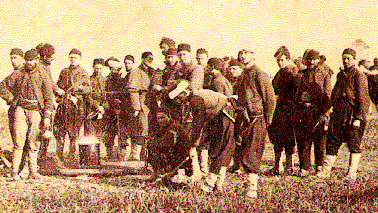 ON APRIL 12, 1861, a group of military
enthusiasts gathered in Manhattan to form a volunteer regiment for two year's service in
the cause of the Union. Their unanimous choice for commander of what was initially called
the "Advance Guard" was Colonel Abram Duryée, a wealthy mahogany importer with
three decades of experience in the 7th New York State Militia. At Duryée's suggestion the
new unit was outfitted in a colorful variation of the Zouave uniform, described by one
reporter as a "wild Saracenic costume." The flashy attire and Duryée's
reputation attracted hundreds of eager volunteers for the 5th New York, or "Duryee's
Zouaves." ON APRIL 12, 1861, a group of military
enthusiasts gathered in Manhattan to form a volunteer regiment for two year's service in
the cause of the Union. Their unanimous choice for commander of what was initially called
the "Advance Guard" was Colonel Abram Duryée, a wealthy mahogany importer with
three decades of experience in the 7th New York State Militia. At Duryée's suggestion the
new unit was outfitted in a colorful variation of the Zouave uniform, described by one
reporter as a "wild Saracenic costume." The flashy attire and Duryée's
reputation attracted hundreds of eager volunteers for the 5th New York, or "Duryee's
Zouaves."
Fierce combat and deprivation lay ahead for these
Zouaves, posing in camp in Virginia in 1861. Many of these men undoubtedly became
casualties, as more than 500 soldiers from the 5th would fall over the next 18 months. Photo
by George Stacy.
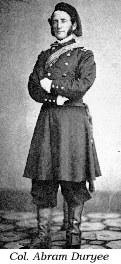 While most recruits hailed from Manhattan, 30 enlistees came
from Poughkeepsie, and Long Island also supplied a sizeable contingent. An effort was made
to select men who were educated, physically imposing, and taller than average. Some had
served in European armies while others were college graduates, law students, or successful
businessmen -- in keeping with Duryée's intention to forge a disciplined, professional
fighting machine. Dispatched to historic Fort Schuyler for their initial training, the
fledgling warriors began to learn their trade under the tutelage of an experienced cadre
of officers. Lt. Col. Gouverneur Kemble Warren and Capt. Judson Kilpatrick were graduates
of West Point, and eight of the company commanders were veterans of the State Militia.
"I expect every man to do his duty and I expect to do mine," Duryée told his
troops; "I hope to make this regiment a glory for the State." While most recruits hailed from Manhattan, 30 enlistees came
from Poughkeepsie, and Long Island also supplied a sizeable contingent. An effort was made
to select men who were educated, physically imposing, and taller than average. Some had
served in European armies while others were college graduates, law students, or successful
businessmen -- in keeping with Duryée's intention to forge a disciplined, professional
fighting machine. Dispatched to historic Fort Schuyler for their initial training, the
fledgling warriors began to learn their trade under the tutelage of an experienced cadre
of officers. Lt. Col. Gouverneur Kemble Warren and Capt. Judson Kilpatrick were graduates
of West Point, and eight of the company commanders were veterans of the State Militia.
"I expect every man to do his duty and I expect to do mine," Duryée told his
troops; "I hope to make this regiment a glory for the State."
ON MAY 24, THE Regiment paraded down
Broadway, past cheering throngs, and boarded a transport en route for the Virginia
Peninsula. Within days of their arrival at Fort Monroe, Col. Duryée began dispatching his
companies on scouting expeditions that impressed the local populace and prompted Pvt.
George Tiebout to write, "Our regiment is called the red-legged devils, and the
terror to evil-doers."
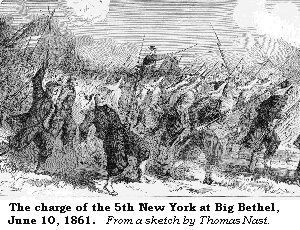 The
next day, June 10, Tiebout became the unit's first fatality in the mismanaged Federal
attack at Big Bethel. The
next day, June 10, Tiebout became the unit's first fatality in the mismanaged Federal
attack at Big Bethel.
Charging an entrenched foe through a hail of canister shot,
Pvt. Thomas Murphy saw a comrade's head "blown about twenty feet from his body,"
while other soldiers had their muskets knocked from their grasp by jagged iron shards.
"There were dead and wounded all around," observed Pvt. Karl Ahrendt, "arms
and hands lying on the ground, maimed bodies, horrible scenes." In their baptism of
fire the 5th NY lost 31 men, seven of them killed or mortally wounded. Lt. Col. Warren
called Big Bethel "an inglorious affair," and when Col. Duryée was given
command of a brigade, Warren imposed an even more rigorous program of drill and military
instruction on the Zouaves.

AT THE END OF July, the 5th NY
was transferred to Baltimore, where they commenced an eight-month stint of garrison duty
atop Federal Hill, helping to enforce Federal control over the pro-Southern city. When
Duryée was promoted general, G.K. Warren became the Zouaves' commander, and ably assisted
by Lt. Col. Hiram Duryea, set about transforming the New Yorkers into one of the most
tactically accomplished units in the service. Warren's troops constructed an elaborate
earthwork on Federal Hill, and were trained to operate the fort's big guns; they mastered
the complex bayonet exercise, and practiced battalion maneuvers at the double-quick.
Companies E and I, armed with breech-loading Sharps Rifles, became adept at skirmishing by
bugle calls. By March of 1862 Surgeon Henry May reported, "The Zoo-Zoos are as near
perfection in drill as it seems possible for a corps to be." Their soldierly demeanor
won the respect of Baltimoreans, and many Zouaves, Col. Warren among them, became engaged
to local women. A bloodless expedition to the Eastern shore of Virginia wet their appetite
for action, and tired of drills and parades, the Zouaves welcomed orders to join Gen.
George B. McClellan's Army of the Potomac for the campaign against Richmond.
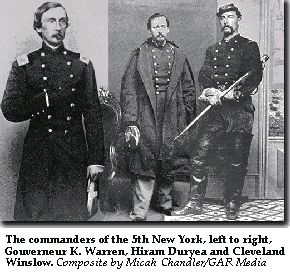 The colorful New Yorkers were an impressive
sight, and in tribute to their military proficiency McClellan attached them to Gen. Sykes'
division of Regular Army troops in the Fifth Corps. Artillery Col. Charles Wainwright
thought "The Fifth New York is equal in all respects to the Regulars and better
drilled." Giving Col. Warren command of a brigade, McClellan stated, "the Fifth
is the best disciplined and soldierly regiment in the Army." It was no wonder that
through all the trials to come, "Little Mac" would always retain the admiration
of the "Red Devils." The colorful New Yorkers were an impressive
sight, and in tribute to their military proficiency McClellan attached them to Gen. Sykes'
division of Regular Army troops in the Fifth Corps. Artillery Col. Charles Wainwright
thought "The Fifth New York is equal in all respects to the Regulars and better
drilled." Giving Col. Warren command of a brigade, McClellan stated, "the Fifth
is the best disciplined and soldierly regiment in the Army." It was no wonder that
through all the trials to come, "Little Mac" would always retain the admiration
of the "Red Devils."
FOR NEARLY THREE MONTHS, McClellan's
offensive lumbered toward the environs of Richmond. Fever, heat-stroke and disease thinned
the ranks of the 5th NY, and their uniforms became worn and ragged. The unit came under
fire during the siege of Yorktown, where they put their Heavy Artillery skills to good use
in constructing and manning entrenched batteries. They played a minor but praiseworthy
role in the fight at Hanover Courthouse on May 27. But it was a month later, in the
desperate engagement at Gaines' Mill, that the Duryee Zouaves won immortal renown for
their ferocious determination amidst the bloodiest of the Seven Days battles.
Gaines' Mill to the Post-War Years

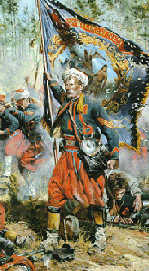 ON JUNE 27, 1862, as the Fifth Corps attempted to cover McClellan's
change of base to the James River, Warren's troops launched a furious counterattack
against the oncoming ranks of Gregg's South Carolina brigade. Riding up to Lt. Col.
Duryea, Warren shouted, "Advance the colors! Advance the colors! Charge!" and
with their flags in the vanguard, the cheering Zouaves swept over the field with leveled
bayonets. One Carolinian called the Zouave onslaught "the most desperate charge I
ever witnessed," and the Rebel attack recoiled. But more Southern troops joined the
fray, and the fighting ebbed and flowed across the corpse-strewn plateau. "The noise
was terrific," Sgt. Thomas Southwick recalled, "but loud above all was the
exultant, fiendlike yell of the Confederate soldiers." Soaked with sweat and stained
with gunpowder, the Zouaves maintained their formation amidst the collapsing Union line.
At one point Lt. Col. Duryea had his men halt under fire and count off, so that every
soldier was in his proper place. ON JUNE 27, 1862, as the Fifth Corps attempted to cover McClellan's
change of base to the James River, Warren's troops launched a furious counterattack
against the oncoming ranks of Gregg's South Carolina brigade. Riding up to Lt. Col.
Duryea, Warren shouted, "Advance the colors! Advance the colors! Charge!" and
with their flags in the vanguard, the cheering Zouaves swept over the field with leveled
bayonets. One Carolinian called the Zouave onslaught "the most desperate charge I
ever witnessed," and the Rebel attack recoiled. But more Southern troops joined the
fray, and the fighting ebbed and flowed across the corpse-strewn plateau. "The noise
was terrific," Sgt. Thomas Southwick recalled, "but loud above all was the
exultant, fiendlike yell of the Confederate soldiers." Soaked with sweat and stained
with gunpowder, the Zouaves maintained their formation amidst the collapsing Union line.
At one point Lt. Col. Duryea had his men halt under fire and count off, so that every
soldier was in his proper place.
Above right, "The Red Devils" -- The 5th
New York at Gaines' Mill, by Don Troiani. Click for a full-image view. (101KB)
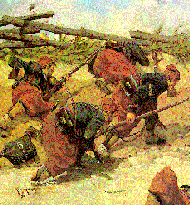

The battle of Gaines' Mill made it clear to friend and foe
alike that the Duryee Zouaves were more than a colorful ornament on the parade ground. Of
450 men who entered the fight, 162 had fallen. "I consider it an honor to belong to
this regiment," Lt. Charles Montgomery wrote; "The Regular officers cannot speak
too highly of us." One Southern soldier told a captive Zouave, "they never had
seen the superiors of the red legs for unflinching courage and coolness." It was a
reputation proudly maintained through the following days of hardship that brought
McClellan's Army to its new base of operations at Harrison's Landing.
The 5th New York moving under fire at Gaines'
Mill, by Keith Rocco.
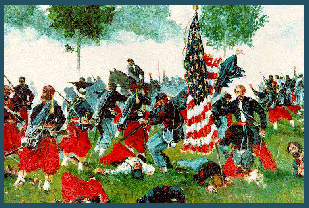
IN MID-AUGUST, THE
ZOUAVES were among Army of the Potomac troops transported north, to join the forces of
Gen. John Pope. Hiram Duryea had been sent home with malaria, and the 5th NY went into the
battle of Second Bull Run (Manassas) under the command of Capt. Cleveland Winslow, son of
Regimental Chaplain Gordon Winslow. On the afternoon of August 30, 1862, Col. Warren
deployed his little brigade -- the 5th and 10th NY -- in support of Hazlett's Battery,
directly in the face of the Confederate juggernaut rolling down on Pope's naked left
flank. It was a desperate act of sacrifice, intended to buy time, and the Duryee Zouaves
paid a terrible price. "Where the Regiment stood that day was the very vortex of
Hell," Pvt. Andrew Coats remembered; "Not only were men wounded, or killed, they
were riddled."
Above right, the Fifth takes the brunt of a Confederate
assault at 2nd Bull Run, caught in a "perfect hail of bullets," in a painting
commissioned by the National Park Service.

Caught in a murderous crossfire from the Texas Brigade, the
New Yorkers were scythed down where they stood in line of battle. Some men were struck
five or even seven times in a matter of seconds, and as the Rebel pincers closed around
them, Col. Warren ordered the survivors to break for the rear. "I saw my comrades
dropping on all sides," Pvt. Alfred Davenport wrote, "canteens struck and flying
to pieces, haversacks cut off, rifles knocked to pieces; it was a perfect hail of
bullets." In less than eight minutes 330 of the 500 Zouaves enaged were put out of
action, 120 of them dead or dying -- the greatest battle fatality of any Federal infantry
unit in the War. Capt. Winslow was one of only three officers who escaped the slaughter,
and although every man but one in the Color Guard was killed, the precious banners were
brought safely from the field, stained with the blood of their fallen bearers.
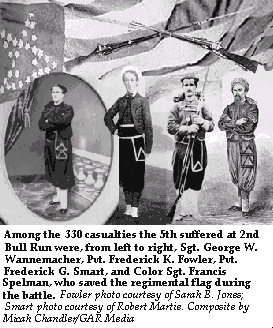
Their ranks again bolstered with recruits, the 5th NY marched
on to Antietam, where on September 17 they were held in reserve during the War's bloodiest
day. Three months later they fought at Fredericksburg, and on December 15 helped cover the
Federal retreat from the ravaged town. Following several months in winter quarters, Col.
Cleveland Winslow led the Zouaves in their final campaign, culminating in Hooker's defeat
at Chancellorsville. "The officers and men of the Fifth New York behaved as they have
always done," brigade commander Patrick O'Rorke reported; "I can give them no
higher praise."
WHILE THE TOUGH SURVIVORS of the
two-year regiment returned home to a heroes' welcome, 230 later recruits were transferred
to the 146th NY to finish their three-year enlistments. In June the 146th adopted a Zouave
uniform, and fought gallantly to the end of War, 32 former 5th New Yorkers dying in
service. Other veterans battled in the ranks of the 165th NY, or "Second Battalion,
Duryee Zouaves," and Col. Winslow organized a 5th NY Veteran Volunteer regiment.
These soldiers maintained the uniform and fighting reputation of the Duryee Zouaves to the
final victory at Appomattox.
In the photo below, veterans of Duryee's Zouaves
march in Manhattan on a bygone Memorial Day.
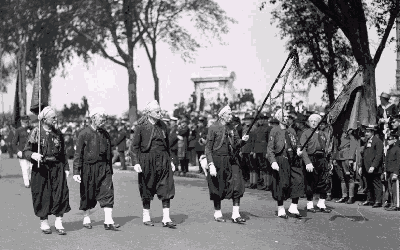 After the war, determined to keep alive the heroic legacy of Duryee's Zouaves,
members of the 5th New York Veterans Association held monthly meetings, erected
battlefield memorials and marched in commemorative parades into the 1930s. When William
McGuffage, the last of Duryee's Zouaves, died on May 12, 1940, he was two months shy of
his 100th birthday. These old soldiers would no doubt have agreed with veteran Alfred
Davenport, who wrote, "there are none but are proud to say that they served in the
5th New York Zouaves." It is a heritage of valor deeply cherished by members of
today's Duryee Zouaves, and one we are equally proud to represent to new generations. After the war, determined to keep alive the heroic legacy of Duryee's Zouaves,
members of the 5th New York Veterans Association held monthly meetings, erected
battlefield memorials and marched in commemorative parades into the 1930s. When William
McGuffage, the last of Duryee's Zouaves, died on May 12, 1940, he was two months shy of
his 100th birthday. These old soldiers would no doubt have agreed with veteran Alfred
Davenport, who wrote, "there are none but are proud to say that they served in the
5th New York Zouaves." It is a heritage of valor deeply cherished by members of
today's Duryee Zouaves, and one we are equally proud to represent to new generations.
 |

